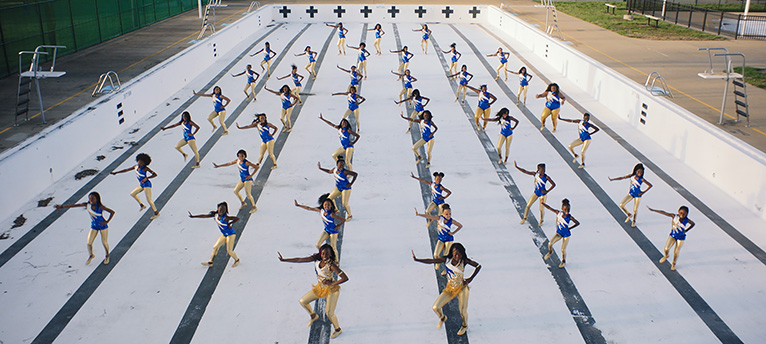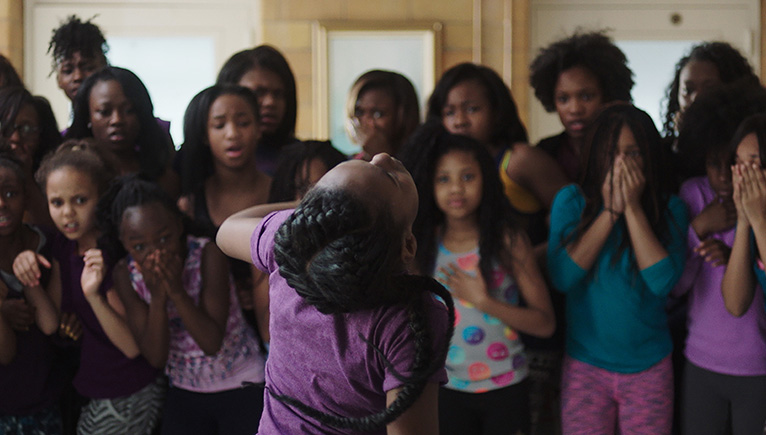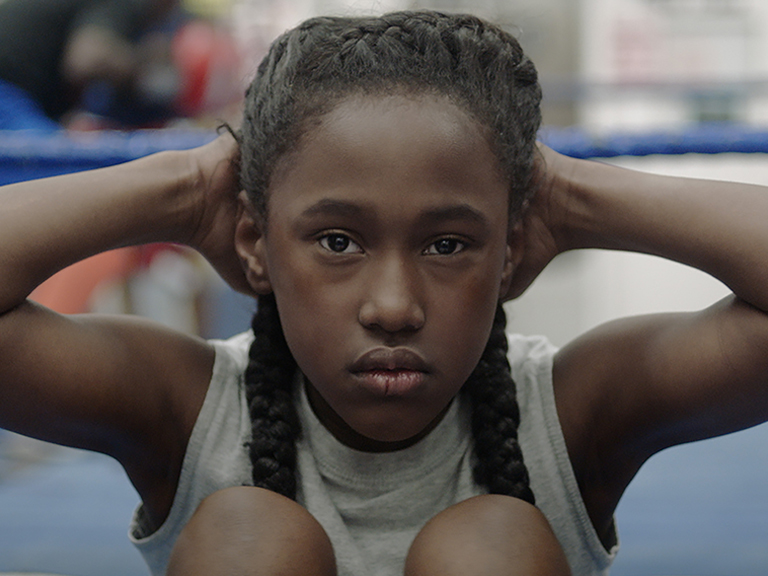Anna Rose Holmer’s The Fits flips the traditional dance script on its ass
DANCE, in mainstream Hollywood dance films, often appears as a weapon. The antagonist is danced against -- and that antagonist takes the form not just of a rival dancer, but of a race and/or class barrier. Dance is positioned as a vehicle of upward mobility and as an equalizing force. In the day-to-day oppression of poverty and racism, it is the dancer’s physical release of this trauma that grants them social acceptance.
Take Flashdance (1983), where Pittsburgh welder Alex Owens uses her talent as a dancer to help pay the rent by stripping. She perseveres to eventually land a wealthy boyfriend and a successful audition to Harvard. Sara, of Save the Last Dance (2001), must overcome debilitating emotional trauma and flashbacks of the car accident that killed her mother, as well as her position as white girl pariah in an unspecified all-black neighborhood in Chicago. Jessica Alba’s Honey (2003) tells of a kind-hearted hip-hop dancer who must work her way out of being an eye-candy bartender. Both Footloose (1984) and Dirty Dancing (1987) invoke class struggle, though within primarily white communities. Ditto for Grease (1978) and Dirty Dancing: Havana Nights (2004).
From the basic plotline -- shut up and dance -- follows hard work, an improvement montage of some sort, and, always, a grand finale pay-off. Dance -- and the good guys always prevail.
The repetitive premise of these films reinforces ideas that are both radical and intuitive: the everyday traumas of racism, classism, and sexism live, at least in part, in the body; and the physical release of that trauma through dance is redemptive. While this approach to trauma is progressive, the formula’s other simplified trappings -- of love, of what it takes to “succeed” in America -- undermine the capacity for a narrative that challenges social structures.

In her directorial debut The Fits, released in June, Anna Rose Holmer flips the traditional dance script on its ass to deliver an understated but fantastical investigation of black female socialization and #blackgirlmagic through ritualized drill and majorette dance. Written by Saela Davis, Holmer, and Lisa Kjerulff, the film plays as if a wily auteur got hold of the footage for a commercial dance film, studied it at length, and then chopped it up and reassembled it with spirit possession.
Where the commercial dance film prioritizes heterosexual romance and meritocratic narratives, Holmer slows -- and quiets -- her story, stripping it almost completely of references to the world outside of a recreation center. The entire film takes place indoors, and within the immediate surroundings, of a community recreation center in Cincinnati’s African-American West End, where young black men and women train as boxers and dancers. Echoing practices of collaborative ethnographic cinema, the specific location was selected for actors chosen by the filmmakers: real-life athlete members of Cincinnati’s Q-Kidz dance team and Queen City Boxing Club. Shots are extended and contemplative, peering between cracks and from corners, and the score hits eerie marks of horror. Adults are spare, insignificant.
The film hones in on the interior experience of 11-year-old protagonist Toni. The “tomboyish” Toni begins as a boxer mentored by her older brother, but quickly becomes interested in dancing with the Lionesses, an all-female dance troupe led by older girls. She soon becomes a “crab,” as the young newcomers to the team are called, and embarks on a fierce -- if awkward -- journey to feminize her body on her own terms.
Where the commercial dance film often sidesteps what it means to have a female body, or to learn how to use it, The Fits begins with breath. Before a single frame appears on screen, Toni’s labored breathing can be heard, as though you are doing the sit-ups yourself.
As a group, the girls tend to each other’s developing femininity, giving temporary tattoos (which Toni picks off), brushing hair, painting nails, and piercing Toni’s ears in the locker room (Toni takes out the studs later). In an expanded moment of reflective minutiae, Toni looks at herself in the mirror, framing her face with a finger-triangle.
Team captain Karisma’s militaristic tone (“Stop thinking like an individual and start thinking like a team”) and desire to uphold the Lionesses’ record as citywide champions gestures towards a more standard dance movie. But the plot turns sharply when Karisma is suddenly “taken” by a mysterious, frightening seizure. The team huddles over their captain, whose body jerks and writhes on the gym floor. Bodies are all kinds of weird and powerful work.
The brief outbursts soon spread as an epidemic throughout the dance team, beginning with the older girls. By the time the younger girls start having their “fits,” what started as a horror close to possession has become a source of fascination, slowly integrated as an inevitable rite of passage -- even a desirable one. “You know it’s gonna happen to us,” Maia tells Toni, “I just want to know how it feels.”
The Fits in many ways emulates the plots of horror films -- in particular the recent It Follows, in which pursuit by peripatetic monsters is transmitted through sexual contact. “Maybe it’s a boyfriend disease,” says fellow dancer Beezy of the fits. It may be. The film’s subtle preoccupation with fluids and purity alludes to menstruation and sexual maturity. At the same time, its concerns with water purity also evoke the racialized environmental plights of low-income communities.
When more and more girls get taken by seizures, the center’s water supply becomes suspect and is tested by external investigators -- the only white characters in the film. These fears of contamination echo the acts of discrimination historically perpetuated through myths of disease cast in scientific rhetoric.
And such fears turn out to be yet another unsolved mystery: the water is revealed to be clean, even as the fits continue. No fit is the same. Where Karisma collapses to the floor and jerks sporadically in front of the whole team, Beezy vibrates in her chair like a jackhammer for an audience of one, a visiting social worker. “We did not give [the actresses] any visual reference for what a fit should look like,” Holmer told BUST. Instead, each dancer designed their own fit with the help of Holmer and the film’s movement consultant.

As witnessed from Toni’s perspective, the fits share much with the stylized routines of the team. Both are viewed in focused fragments, the lens taking in the small twitches and embellishments, from Karisma’s intentional hair flip to her fit-induced belabored gasps. Both forms incorporate violent movements. Dancing represents work towards reaching a powerful, controlled feminine ideal of sexiness and strength. The fits are a closely related inverse; they are highly physical and gendered, but instead represent the loss of bodily control through a mysterious spasm.
Are the fits purely a metaphor for the trauma of women’s coming-of-age? The film never quite says. As the viewer is left grasping for a specific antagonist, a more important question arises: What purpose would diagnosing the origins of the illness serve? Which is also to ask: who would it serve best? Establishing the fits as performative would do a disservice to the reality of the dancers’ experience, while completely ignoring the girls’ complicity in the epidemic would be to miss the plot, and the point.
These young women’s bodies craft an alternative to language. As historian Stacy Schiff writes about the young women of Salem, from centuries earlier, “the girls expressed in fits what they could not entrust to words.” To switch languages -- to code-switch -- is to change the terms of engagement in a world that places them at multiple disadvantages.
Where the dance film positions this mode ultimately as a means of integration with a status-quo society, The Fits stubbornly returns to Toni’s self-evolution as the only significant barometer of accomplishment. Toni has achieved success because of her experience and passage -- not because she made best friends, learned to dance, won a competition, or fell in love.
The viewer is forced to let go of an expectation for external forms of validation -- or else be disappointed and vexed. The energetic dance numbers that audiences are trained to expect never materialize. The citywide competition quickly fades from view. Practice is usually without music. At least once, music is denied: Karisma commands, “Cue the music,” as the scene cuts to the locker room.
But the grand finale is a dance film requisite that Holmer does not withhold. Toni’s culminating fit marks her transition from one form of physical power to another. In this dreamlike fantasy, Toni’s feet float above the ground, her braids thrash wildly and a vision of the Lionesses appears: they perform in perfect unity, resplendent in blue and gold sequins and full make-up as Kiah Victoria sings, “We choose to be slaves to gravity.”
In these final scenes, Holmer conjures the mourning and ecstasy of balancing choice and surrender, lending depth to the typically flat spectacle of synchronized movement. As she told Vogue, “We’re saying that there is power in collective identity. And it should not be conflated with conformity. There is that fear, though, and it’s real.”
